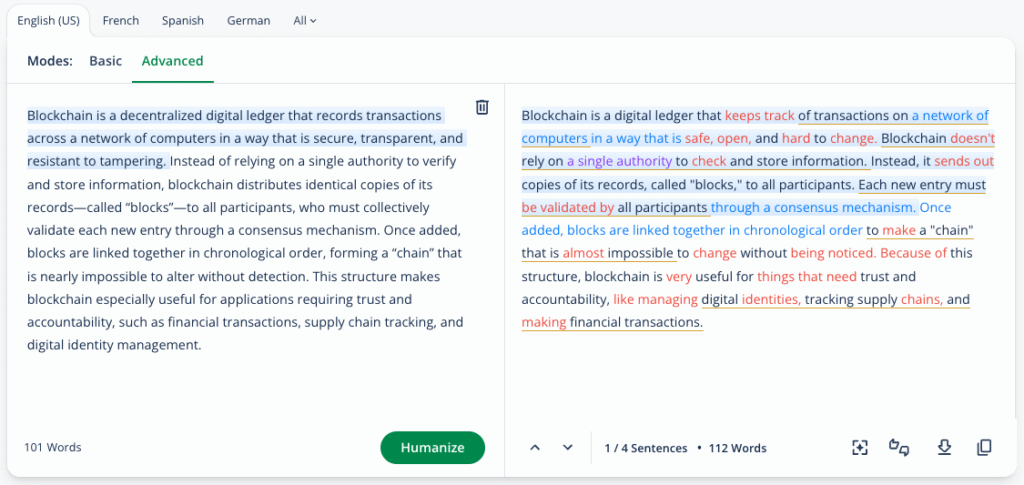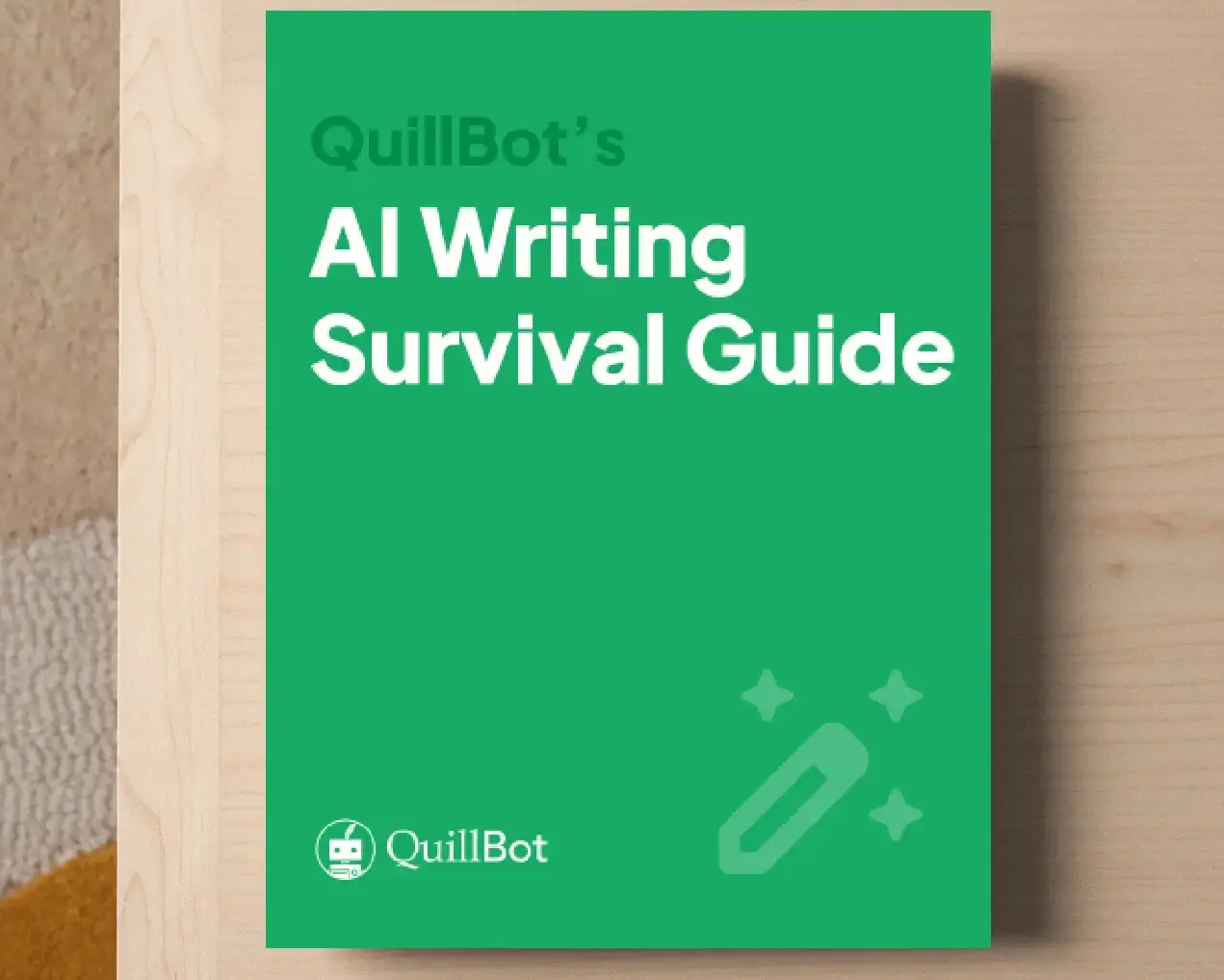How to Make AI Sound More Human | 7 Tips to Add Authenticity
If you’re using AI as a co-creator to help you produce written content, you’ll know what a valuable tool it can be in terms of creativity and efficiency. You’ll also know that humanizing the AI output is an important step in the process of creating natural-sounding texts that connect with your audience.
Making AI-generated text sound more human is about understanding why it can sometimes come across as a bit robotic and developing the editing skills to efficiently shape it into something more authentic. You can use an AI humanizer to make this task easy.
Characteristics of AI text
Chatbots like QuillBot’s AI Chat or ChatGPT produce human-like text using generative AI technology. The responses to the prompts you give them are based on predictions of what the next word (or part of a word) should be in the given context.
AI-generated texts aren’t the result of facts and phrases recalled from a human-like memory—they’re statistical predictions shaped by the patterns and relationships the AI model learned during its training. Although AI texts are becoming increasingly authentic-sounding as the technology improves, they often need some editing to address:
- Stylistic inconsistencies
- Unnatural word choices
- Inauthentic sentence patterns
- Redundant generic statements
7 ways to make AI text sound more human
Here are seven suggestions to help you make an AI text sound more human, covering style, phrasing, sentence patterns, prompts, and tools.
1. Find the right tone
Tweak the AI text so it creates the right impression or reflects the personality of the brand, organization, or publication you’re writing for. If you’ve been given guidelines for a brand voice or tone, take a moment to read them through again before you start editing.
2. Check for unnatural word combinations
Perhaps your AI co-creator has been too poetic at times, and some of the phrasing sounds slightly off when you read it aloud.
- In the sentence, “We’re building a kinder, more sustainable way to eat,” you might find “building” an odd word choice, so you go with “creating” instead.
- You change “All our vegetables are grown thoughtfully” to “grown by responsible local farmers” because using the adverb “thoughtfully” to describe how vegetables are grown sounds slightly awkward.
3. Look for unnatural patterns
AI output sometimes falls into predictable underlying patterns that make a text feel a bit robotic or uncanny.
You can make your AI sound more human by looking out for, and breaking up, patterns like these:
- Sentences or paragraphs that are very similar in length
- Overuse of certain sentence structures, like ending sentences with a phrase or clause after an em dash (e.g., “We deliver seasonal fruit and vegetables—so you get them when nature intended”)
- Paraphrased repetition of the same ideas or information
- Excessive use of topic-related keywords
4. Introduce some personalization
Look for opportunities to supplement your AI text with details, stories, or anecdotes about real people, such as team members or customers.
Maybe you can make it sound more human with references to specific events or community initiatives that the AI wouldn’t know about.
We’ve been delivering boxes to Nicola for almost 10 years now.
You can meet our farmers at our annual summer festival.
5. Add examples and evidence
AI tends to be generic if it doesn’t have enough specific information about a topic, so adding concrete details, statistics, or real-world evidence can help to humanize a text.
Humanized text: 70% of our produce comes from farms within 20 miles of Scranton.
AI-generated text: We support local farmers
Humanized text: Our support for local farmers has been recognized with a Supporter of Local Agriculture award.
6. Revise the prompt
You’re using AI to help you write better texts and save time, so if it’s taking too long to humanize the output, it might be worth revisiting your prompt.
Try fine-tuning elements like:
- Persona (e.g., “You are a copywriter who specializes in marketing texts”)
- Tone (e.g., “friendly,” “clear and direct,” “Use informal language, contractions like ‘we’re’, and address the reader as ‘you’”)
- Voice (e.g., “community focused,” “honest,” “down-to-earth”)
You can also get more human-sounding output by providing examples of similar texts. If you’re writing for a website, for instance, try including samples of existing pages.
7. Use a humanizer tool
Humanizers like QuillBot’s free AI Humanizer tool can help you to efficiently improve output generated by the likes of ChatGPT, Gemini, Claude, and DeepSeek. Our AI Humanizer suggests more natural-sounding phrasing, transitions to improve flow, and ways of breaking up repetitive sentence structures. It also allows you to swap out synonyms in the humanized output to gain even more control over tone and style.
Ask ChatGPT to summarize this page
Frequently asked questions about how to make AI sound more human
- What are some common AI words?
-
Some common AI words are:
- Tapestry
- Crucial
- Intricate
- Interplay
- Elevate
- Resonate
- Enhance
- Offerings
- Leverage
- Embark
Just because you see one of these words in a text doesn’t mean it was written by AI. But these words are commonly used when AI generates content.
If you’re learning how to detect AI writing, brushing up on common AI words is one way to do that.
You could use the QuillBot AI Detector to analyze writing and see if it looks like it was created by AI. You can also use our AI Humanizer to rephrase and refine the text.
- How do I spot AI-generated text?
-
One easy way to spot AI-generated text is to use an AI detector, which analyzes text features to determine whether they are more similar to human-written or AI-generated samples.
You can also sometimes spot features of AI-generated text on your own. AI content tends to be more predictable and formulaic than human content and sometimes has a stiff or formal tone.
When you’re trying to detect AI writing, keep in mind that no approach is 100% reliable. QuillBot’s free AI Detector provides a detailed report that gives percentages for both AI-generated and AI-refined content, which can help you make more informed decisions.
Cite this Quillbot article
We encourage the use of reliable sources in all types of writing. You can copy and paste the citation or click the "Cite this article" button to automatically add it to our free Citation Generator.
QuillBot. (2025, October 28). How to Make AI Sound More Human | 7 Tips to Add Authenticity. Quillbot. Retrieved November 3, 2025, from https://quillbot.com/blog/ai-writing-tools/how-to-make-ai-sound-more-human/


